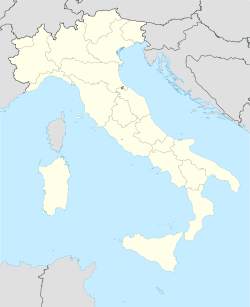Pistoia
| Comune di Pistoia | |
|---|---|
 |
|
| Country | |
| Region | Tuscany |
| Province | Pistoia (PT) |
| Mayor | Renzo Berti (from May 2002) |
| Elevation | 65 m (213 ft) |
| Area | 236 km² (91.1 sq mi) |
| Population (as of September 31, 2006) | |
| - Total | 92,267 |
| - Density | 391/km² (1,013/sq mi) |
| Time zone | CET, UTC+1 |
| Coordinates | |
| Gentilic | Pistoiesi |
| Dialing code | 0573 |
| Postal code | 51100 |
| Frazioni | see list |
| Patron | St. Jacopo |
| - Day | July 25 |
| Website: www.comune.pistoia.it | |



Pistoia is a city in the Tuscany region of Italy, the capital of a province of the same name, located about 30 km west and north of Florence.
Contents |
History
Pistoria (in latin other possible spellings are Pistorium or Pistoriae) was centre of Gallic, Ligurian and Etruscan settlements before becoming a Roman colony in the 6th century BC, along the important road Via Cassia: in 62 BC the demagogue Catiline and his fellow conspirators were slain nearby. From the 5th century the city was a bishopric, and during the Lombardic kingdom it was a royal city and had several privileges. Pistoia's most splendid age began in 1177 when it proclaimed itself a free commune: in the following years it became an important political centre, erecting walls and several public and religious buildings.
In 1254 the Ghibelline Pistoia was taken over by Guelph Florence, but supposedly resulted in the division of the Guelphs into "Black" and "White" factions. Pistoia remained a Florentine holding except for a brief period in the 14th century, when Castruccio Castracani captured it for Lucca, and was officially annexed to Florence in 1530. During the 14th century Ormanno Tedici was one of the Lords of the city.
In 1786 a famous Jansenist episcopal synod was convened in Pistoia.
Dante mentioned in his Divina Commedia the free town of Pistoia as the home town of Vanni Fucci, who is encountered in Inferno tangled up in a knot of snakes while cursing God, and Michelangelo called the Pistoiesi the "enemies of heaven".
Pistoia lent its name to the pistol[1], which it started manufacturing in the 16th century. But today it is also notable for the extensive garden nurseries spreading around it. Consequently, Pistoia is also famous for its flower markets, as is the nearby Pescia.
Main sights
Although not as visited as other towns in Tuscany, mostly due to the industrial environs, Pistoia presents a well-preserved and charming medieval city inside the old walls.
Piazza del Duomo
The large Piazza del Duomo is lined with attractive original buildings as the Palazzo del Comune and the Palazzo del Podestà: it is the setting (in July) of the Giostra dell'Orso ("Bear Joust"), when the best horsemen of the districts of the town tilt with lances at a target held up by a dummy shaped like a bear.
The original Cathedral of San Zeno (5th century) burned down in 1108, but was rebuilt during the following century, and received incremental improvements until the 17th century. The façade has a prominent Romanesque style, while the interior received heavy Baroque additions which were removed during the 1960s. Its outstanding feature is the Altar of St James, an exemplar of the silversmith's craft begun in 1287 but not finished until the 15th century. Its various sections contain 628 figures, the total weighing nearly a ton. The Romanesque belfry, standing at some 67 m, was erected over an ancient Lombard tower.
In the square is also the 14th century Baptistry, in Gothic style, with white-green marble decorations.
The Palazzo dei Vescovi ("Bishops' Palace") is characterized by a Gothic loggiato at the first floor. The Tower of Catilina is from the High Middle Ages, and stands 30 m high.
Other relevant buildings
- Church of the Madonna dell'Umiltà (1509), finished by Giovanni Vasari with a 59 m-high cupola.
- Church of San Bartolomeo in Pantano (12th century).
- The Romanesque church of San Giovanni Fuoricivitas (12th-14th century).
- The Monument in Honour of Brazilians (Soldiers and Pilots) killed in action on Italian Campaign (World War II)
- Church of San Domenico.
- Church of Santa Maria delle Grazie.
- Church of San Pietro Maggiore.
- Church of San Paolo.
- Church of La Vergine.
- the Baroque church of Santissima Annunziata, famous for its Chiostro dei Morti ("Dead's Cloister").
- Ospedale del Ceppo (13th century).
- The 14th century walls. These had originally four gates, Porta al Borgo, Porta San Marco, Porta Carratica and Porta Lucchese, all demolished at the beginning of the 20th century.
- The Medici Fortress of Santa Barbara, built in the 16th century by the Florentines.
- The ancient Pieve San Michele in Groppoli, in the neighbourhood of the city.
Notable people born in Pistoia
- Enrico Betti
- Mauro Bolognini
- Cino da Pistoia
- Pope Clement IX
- Ippolito Desideri
- Massimo Freccia (Valdibure)
- Licio Gelli
- Marino Marini
- Filippo Pacini
Frazioni
Badia a Pacciana, Bargi, Bonelle, Bottegone, Canapale, Chiodo, Chiazzano, Chiesina Montalese, Cireglio, Collina, Capostrada, Candeglia, Gello, Le Grazie, Le Piastre, Masiano, Orsigna, Piazza, Piteccio, Pontelungo, Pontenuovo, Pracchia, Ramini, San Felice, Sammommè, Santomato, Saturnana, Spazzavento, Valdibrana, Vicofaro, Sant'Agostino, Torbecchia, Nespolo, Le Querci, Le Fornaci.
Twin towns
Pistoia is twinned with:
 Pau, France, since 1975
Pau, France, since 1975
Footnotes
Bibliography
- David Herlihy. Medieval and Renaissance Pistoia: the social history of an Italian town. New Haven e Londra, Yale University Press, 1967.
External links
- Comune di Pistoia
- Pistoia Tourist Consortium: lots of information and city map download
- Pistoia Blues Festival
- Virtual Tour of the City
|
|||||||
